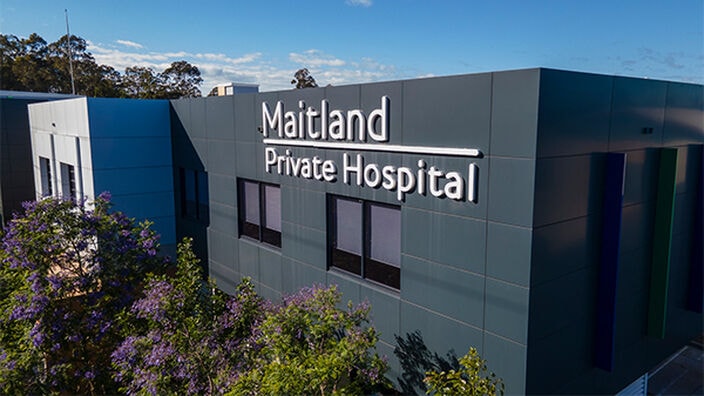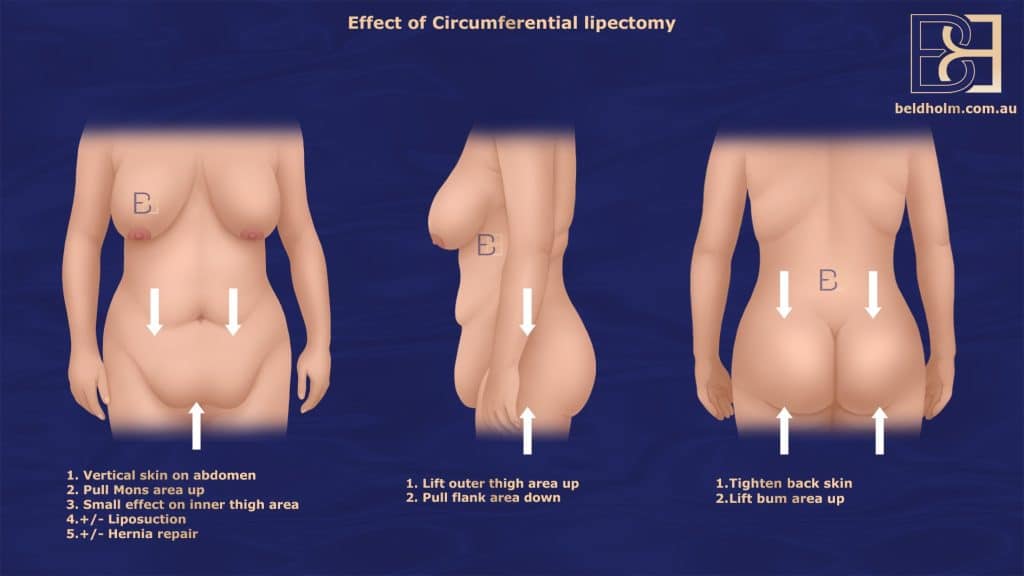

Losing weight is a huge accomplishment, especially if you’ve struggled with obesity all your life. You’ve dieted, exercised, and learned to change your relationship with food.
For many post-weight loss patients, reaching a healthy weight is only the first half of the battle. What comes next might be a body contouring procedure. If you have excess skin 360 degrees around your abdomen, your surgeon at Body Contouring Surgery Clinic may recommend a lower body lift (Belt lipectomy).
This guide to Belt lipectomy surgery covers information such as:
- What is a Belt lipectomy?
- What areas does a Belt lipectomy treat?
- What are the benefits of a Belt lipectomy?
- Who is a candidate for the surgery?
- Are there any risks?
- What happens during the operation?
- How long is the downtime after surgery?
- When will I see the results?
- How do I choose a Belt lipectomy surgeon?
- Answers to FAQs
What is a Belt lipectomy?
A body lift (belt lipectomy) is a comprehensive body contouring procedure that removes excess skin and fat 360 degrees around the waistline. It is designed for patients who have lost significant weight with bariatric surgery or dieting.
It Treats 6 Areas at Once
- Hips
- Thighs
- Buttocks
- Abdomen
- Lower back
- Mons pubis
What are the benefits of Belt lipectomy surgery?
A Belt lipectomy addresses lax skin on several parts of the body. The results are dramatic since it treats the front, back, and sides of your waistline. Combining these procedures into one or two surgeries may reduce your downtime, operating room fees, and anaesthesia costs compared to having several different procedures.
A Belt lipectomy can improve mobility during exercise & eliminate rashes from excess skin.
Am I a candidate for Belt lipectomy surgery?
If you have loose skin on your abdomen, hips, flanks, thighs, and buttocks after losing weight, a Belt lipectomy may be the right surgery for you.
The ideal candidate does not smoke, is in good overall health, and is within 10 kilos of their goal weight. Women must not be pregnant or breastfeeding. Individuals with compromised immunity or serious health issues may not be eligible for the surgery.
The best way to find out if you are a candidate is to book a private consultation with a qualified surgeon that is experienced in post-bariatric body contouring.
If you want to know more about this operation, our body contouring specialists can answer all your questions. We will work with you one-on-one to determine if you are a candidate for a body lift or related skin removal surgeries. Call Body Contouring Surgery Clinic today to book your private consultation.
Our surgeons understand that your physical features and goals after weight loss are unique. During your consultation, we will listen with an open mind and create a bespoke surgical plan that best fits your needs.

Consider a Belt lipectomy if you have:
- Difficulty fitting in clothes
- Limited mobility due to redundant skin
- Excess skin and fat 360 degrees around your waist
- Chronic chafing, rashes, or discomfort from skin folds
Possible Belt lipectomy Risks and Complications
A Belt lipectomy is a major surgery. Even in the hands of an experienced specialist surgeon, risks and complications are possible. Our surgeons will review your medical history with you to determine if you are a good candidate. They will tell you about potential risks that may occur such as:
- Seroma
- Infection
- Necrosis
- Blood clots
- Asymmetry
- Haematoma
- Haemorrhage
- Poor scar healing
- Wound breakdown
- Pulmonary embolism
- Prolonged numbness
- Dissatisfaction with results
- Complications from anaesthesia
We are there for you every step of the way from consultation to recovery. Our highly trained clinical staff will go the extra mile to ensure you have a positive experience. You will also have access to our top-notch aftercare program for 12 months after your surgery.
Steps to ensure a good recovery
You can lower the risk of Belt lipectomy complications by:
- Avoiding nicotine
- Following pre- and post-operative instructions
- Attending follow-up appointments after your surgery
- Calling the office immediately if you notice signs of infection
- Choosing a surgeon who is experienced in body contouring after weight loss
The Surgery: What happens during a Belt lipectomy operation?
The operation lasts approximately six to seven hours. You will be under general anaesthesia, so you won’t feel any pain during your procedure.
VASER Liposuction (suction-assisted lipectomy)
Our surgeons use VASER liposuction (suction-assisted lipectomy) to reduce stubborn fat pockets that remain after weight loss. The VASER probe vibrates to liquefy the fat cells. Once liquefied, we will extract the fat with a suction cannula. We prefer VASER liposuction (suction-assisted lipectomy) instead of standard liposuction. Our surgeons find that VASER causes less tissue trauma, so there is less bleeding and bruising.
Skin Removal
Our surgeons remove the lax skin with a long incision that goes all the way around the belt line. They will turn you over on the operating table to access your front and back. If necessary, they will repair your abdominal muscle separation. When they pull your skin up to close the incision around your waistline, it lifts and tightens the abdomen, hips, flanks, thighs, mons, and buttocks.
Closing the Incision
When closing your incision, our surgeons will apply fibrin tissue glue as they suture your incision closed in layers. The closure is nice and tight, so there is less room for serous fluid to accumulate. This step is critical since seroma is one of the most common complications after a Belt lipectomy.
Belt lipectomy Recovery
You will wake up in a private recovery room at the hospital. A highly trained nurse will be by your side. They may provide a small snack such as crackers and water in case you feel nauseous from the anaesthesia. Most patients stay in the hospital for 2 to 4 days.
Pain Relief
Expect to feel tired, groggy, and sore on your first day. Discomfort tends to peak 24 to 72 hours after surgery, then gradually subsides. You will be prescribed medications. Remember, post-operative discomfort is temporary.
Walking
While you might not feel 100 percent, it is important to take short walks every day while you are in the hospital. Medical staff will be available to help you rise from bed and take short walks in the hallway.
Swelling
Your mid-section will appear very swollen. This is a normal side effect of surgery. You can decrease swelling by drinking water. While it sounds counterintuitive, staying hydrated is an effective remedy. At three months post-op, nearly 60% of swelling should resolve. It can take 12 months for all the swelling to dissipate.
Showering
Your incision will be bandaged with a PICO wound dressing. This advanced battery-powered dressing exerts negative pressure on the wound to speed healing. It features AIRLOCKTM technology to keep out up to 99.9 percent of bacteria. The PICO dressing and battery can’t get wet, so you will need to take bird baths until your surgeon removes it seven to ten days later.
Compression Garment
Our surgeons may ask you to wear a compression garment to reduce swelling. You will need to wear the garment 23 hours a day for the first few weeks, then 12 hours a day thereafter for several more weeks. You can remove the garment to shower.
Numbness
Expect to have some numbness in your mid-section after your surgery. Most patients find sensation returns within the first three months. As your nerves heal, you may experience temporary shooting pains.
Driving
Once you’re discharged from the hospital, someone will need to drive you home. You will not be cleared to drive for three to four weeks. When you get into the driver’s seat for the first time, ensure that you feel good enough to drive defensively. Check your mirrors, practice turning to check your blind spots, and make sure you can turn the steering wheel without experiencing pain.
Time Off Work and Exercise
Most patients take three to four weeks off work. If you have a physically demanding job, you may need additional time off. You can resume light exercise at two to three post-op. Avoid heavy lifting, vigorous exercise, and jogging for six to eight weeks.
Scar Care
Your incision should be healing by the time our surgeons remove the PICO dressing. The scar should continue to fade over the next 12 to 18 months.
Belt lipectomy Recovery Tips
- Do not smoke
- Stay hydrated
- Avoid heavy lifting
- Wear loose clothes
- Keep the wound clean
- Walk slowly bent at the waist
- Wear a compression garment
- Take medications as prescribed
- Increase your activity every day
- Attend all follow-up appointments
- Call your surgeon if you have complications
- Stop vitamin E supplements and blood thinners as directed
Belt lipectomy Results
A Belt lipectomy tightens the skin on your abdomen, sides, and flanks. It also lifts and smooths the skin on your thighs and buttocks. Your results will become apparent once the swelling resolves and the scar heals. While you may see an early preview of your results a few weeks after your surgery, it usually takes 12 to 18 months to appreciate your final results. Your loose skin and excess fat will not come back as long as you maintain a stable weight.
Are you interested in seeing Belt lipectomy before-and-after pictures? Call Body Contouring Surgery Clinic today. Our surgeons can show you real patient photos so you get an idea of what to expect.
Choosing A Belt lipectomy Surgeon
To get the best result, speak to a surgeon that features body contouring procedures such as tummy tucks and Belt lipectomy on their website. The surgery is highly complex and requires extensive surgical training.
If you’re considering a Belt lipectomy, seek help from a surgeon with credentials such as FRACS after their name. These credentials indicate that a surgeon has advanced training in surgery.
Belt lipectomy FAQs
Most patients remain in the hospital for five to seven days.
You can take a quick rinse after the first week, just don’t get the PICO dressing wet. You can have a proper shower once we remove the PICO dressing and replace it with Hypafix tape seven to nine days after your surgery.
Generally speaking, the operation time is five to six hours long.
Yes, in some cases, our surgeons may recommend splitting your Belt lipectomy into two surgeries. Some individuals can have a Belt lipectomy in one surgery. We will let you know our recommendation during your private consultation.
Most Belt lipectomy patients start driving at three to four weeks post-op.
A Belt lipectomy has a downtime of two to three weeks before you can return to light work duties. It may take up to three months to feel completely normal. By then, you should be back to all your usual daily activities without restriction.
The scar will be placed 360 degrees around your abdomen.
A Belt lipectomy helps tighten the outer thighs, so it should be performed before you have thighplasty. As specialists in post-weight loss body contouring, our surgeons will map out a plan of when to schedule each surgery.